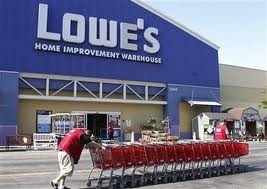 Shoppers are enjoying the generous mark-downs on older merchandise at the second largest home improvement retailer in the United States, but they are hurting Lowe’s bottom line and disappointing investors. In an interview with Businessweek, Lowe’s CEO Robert Niblock explained that although newer stores have experienced an increase in sales by almost two percent after Hurricane Sandy and a jump in residential construction, the chain’s overall clearance strategy is putting a strain on margins.
Shoppers are enjoying the generous mark-downs on older merchandise at the second largest home improvement retailer in the United States, but they are hurting Lowe’s bottom line and disappointing investors. In an interview with Businessweek, Lowe’s CEO Robert Niblock explained that although newer stores have experienced an increase in sales by almost two percent after Hurricane Sandy and a jump in residential construction, the chain’s overall clearance strategy is putting a strain on margins.
On February 25th, shares of Lowe’s dropped 4.8 percent, although they are up by one percent in 2013. By comparison, the S&P 500 index has been on a bullish streak with a 4.3 percent increase this year. Lowe’s is playing catch-up with nemesis Home Depot, but CEO Niblock is looking at other ways to remain competitive. Analysts expected a $2.10 profit per share improvement of Lowe’s, but Niblock believes it will be closer to $2.05. Lowe’s income in the final quarter of 2012 declined by 11 percent, and the heavy mark-downs on old inventory are to blame.
Lowe’s is Still a Buy
Some analysts still recommend Lowe’s stock; after all, the retailer managed to beat expectations with regard to revenue projection. Niblock may be cautious about the company's forecasts for this year, but he spoke about the ongoing increase in home prices and confidence among homeowners. Lowe's is still on track to boost hiring and will focus on keeping sharply discounted items on store shelves throughout the year.
Some of the items that are being aggressively marked down include power tools, countertops and cabinetry. The company is testing seasonal programs such as gardening classes in the spring, and it is also looking at competitive pricing of clean-up items that customers purchase on a year-round basis. Customers are also able to store useful home maintenance data online and set reminders for periodic purchases of certain items like light bulbs, air filters, paint, batteries for smoke alarms, and more.
One more concern that Niblock mentioned is directly related to housing. He sees the strict mortgage lending landscape and the peskily high rates of mortgage delinquency as impediments to the growth of the home improvement industry. Competitor Home Depot is faring better and feeling more confident; the retailer is even considering a future boost of in dividends and feels that it is on track to improve sales by two percent in 2013.



